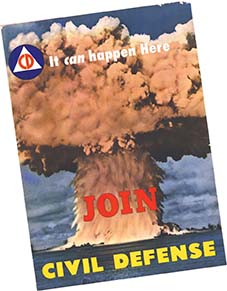SECTION 3: The Cold War Expands

Civil defense poster ►

Nuclear fallout shelter sign ►
WITNESS HISTORY  AUDIO
AUDIO
The Threat of War
After the Soviet Union tested an atomic bomb in 1949, President Truman reported to the nation that the nature of war had forever changed:
“[W]ar has undergone a technological change which makes it a very different thing from what it used to be. War today between the Soviet empire and the free nations might dig the grave not only of our Stalinist opponents, but of our own society…. Such a war is not a possible policy for rational men.”
—President Harry S. Truman
Objectives
- Describe the causes and results of the arms race between the United States and the Soviet Union.
- Explain how Eisenhower’s response to communism differed from that of Truman.
- Analyze worldwide Cold War conflicts that erupted in Eastern Europe, the Middle East, and other places.
- Discuss the effects of Soviet efforts in space exploration.
Terms and People
- arms race
- mutually assured destruction
- John Foster Dulles
- massive retaliation
- brinkmanship
- Nikita Khrushchev
- nationalize
- Suez crisis
- Eisenhower Doctrine
- CIA
- NASA
NoteTaking
Reading Skill: Identify Main Ideas Identify the tactics used to wage the Cold War.
Why It Matters By 1950, the United States and the Soviet Union were the two most powerful nations in the world. The conflicting ideologies and goals of these rival nations led to a worldwide struggle for influence. The policies followed by the two superpowers helped shape the modern history of much of the world, from Latin America to the Middle East. Section Focus Question: What methods did the United States use in its global struggle against the Soviet Union?
The Arms Race Heightens Tensions
A change in the balance of world power is usually gradual, taking place over decades or even centuries. But sometimes, the shift happens in a blink of an eye. Such a major shift in the balance of power in the Cold War took place on September 2, 1949. Instruments in an American B-29 aircraft flying over Alaska detected unusual atmospheric radiation. The radiation cloud was drifting eastward from the direction of Siberia.
American nuclear scientists analyzed the data that the aircraft had gathered. They then reached an inescapable conclusion: The Soviet Union had set off an atomic bomb.
Communist Advances Shock the Nation
The news shook U.S. leaders. They had believed that the Soviet Union was years away from developing an atomic bomb. Now, the Americans no longer had a monopoly on atomic weaponry.
The news that the Soviets had the bomb was followed the next month by news of the communist takeover of China. In a very short time, Americans sensed that the world was a much more dangerous and threatening place.




